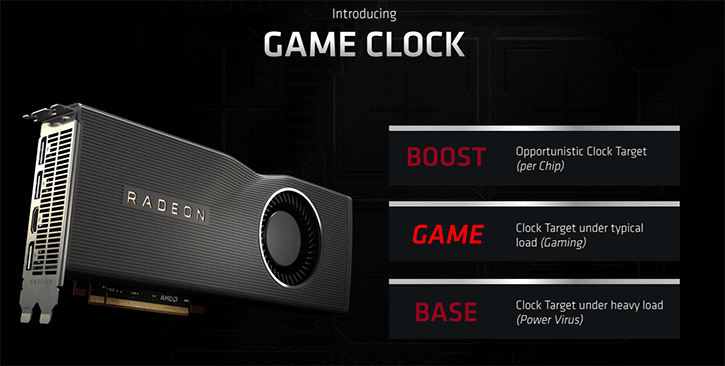Clocks, DDR6 and PCIe 4.0
A new clock frequency denominator
New for the NAVI series is that next to the traditional base and dynamic boost clock, we now move towards a base, game and boost clock. With an application behaving viral like say Furmark, you’ll see the Radeon RX 5700 (XT) specced at 1605 MHz base clock frequency. Gaming on a heavy on the GPU title will result in a 1755 MHz clock frequency. However, where it can it can boost towards 1905 MHz. A little confusing we agree. But arguably you are going to see a 1755~1905 MHz dynamic clock when gaming, differing per title. AMD has indicated that the boost peaks can be even higher than 1.9 GHz. So as far as clear values go, my guess is as good as yours. The dynamic clocks are of course regulated by limiters to be found in power draw, load, heat, voltages, etc.
8GB GDDR6 Graphics memory
Of course, AMD could not retain HBM2 graphics memory, too difficult to assemble, fab and purchase. The logical choice is GDDR6, 8 GB of it is a good number. And as such the GPU features a 256-bit GDDR6 memory interface, roughly doubling memory bandwidth compared to "Polaris." Both NAVI cards will get that 8 GB, there will not be a 4GB model. That also means both cards run a 256-bit wide memory bus and offer 448 GB/s of memory bandwidth which is a massive improvement of last-gen products.
PCI-Express Gen 4.0
We’ve mentioned it already, AMD really wanted to be first with anything and everything PCI-Express 4.0. Yes, AMD has been making big bets with the 2019 products, one of them is making a strong and solid move to surpass the competition, with PCIe Gen 4.0. The 7nm AMD Radeon RX 5700-series gaming graphics card family featuring high-speed GDDR6 memory and support for the PCIe 4.0 interface, on a Ryzen 3000 proc, with X570 motherboard and say a Radeon 5700, you’ll be hard-pressed to run out of bandwidth as each lane get doubled up in that bandwidth, per lane. Of course, there has been a recent PCI-Express Gen 5.0 announcement as well, for ease of mind I already inserted it into the table below.
|
PCIe ss |
Line Code |
Transfer Rate |
x1 Bandwidth |
x4 |
x8 |
x16 |
|
1.0 |
8b/10b |
2.5 GT/s |
250 MB/s |
1 GB/s |
2 GB/s |
4 GB/s |
|
2.0 |
8b/10b |
5 GT/s |
500 MB/s |
2 GB/s |
4 GB/s |
8 GB/s |
|
3.0 |
128b/130b |
8 GT/s |
1 GB/s |
4 GB/s |
8 GB/s |
16 GB/s |
|
4.0 |
128b/130b |
16 GT/s |
2 GB/s |
8 GB/s |
16 GB/s |
32 GB/s |
|
5.0 |
128b/130b |
32 GT/s |
4 GB/s |
16 GB/s |
32 GB/s |
64 GB/s |
Again, if you go with AMD X570 for your choice of motherboard, that currently is the solution that will bring PCIe Gen 4.0 slots towards the platform, and the graphics card. That, however, has to be managed as a single x16 PCIe Gen 4.0 slot or split up into x8 gen 4.0 slots, which effectively is the same bandwidth as two x16 Gen 3.0 slots. Since graphics PCIe lanes are always tied towards the CPU, that means a Ryzen 3000 proc can manage x16 Gen 4.0 for just graphics. So interconnect bandwidth, it’s just not an issue or even a slight challenge.



